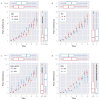Effect of pain location and duration on life function in the year after motor vehicle collision
- PMID: 24972071
- PMCID: PMC4157966
- DOI: 10.1016/j.pain.2014.06.013
Effect of pain location and duration on life function in the year after motor vehicle collision
Abstract
Persistent musculoskeletal pain is common after motor vehicle collision (MVC) and often results in substantial disability. The objective of this study was to identify distributions of post-MVC pain that most interfere with specific life functions and that have the greatest interference with aggregate life function. Study data were obtained from a prospective longitudinal multicenter emergency department-based cohort of 948 European Americans experiencing MVC. Overall pain (0-10 numeric rating scale [NRS]), pain in each of 20 body regions (0-10 NRS), and pain interference (Brief Pain Inventory, 0-10 NRS) were assessed 6 weeks, 6 months, and 1 year after MVC. After adjustment for overall pain intensity, an axial distribution of pain caused the greatest interference with most specific life functions (R(2)=0.15-0.28, association P values of <.001) and with overall function. Axial pain explained more than twice as much variance in pain interference as other pain distributions. However, not all patients with axial pain had neck pain. Moderate or severe low back pain was as common as neck pain at week 6 (prevalence 37% for each) and overlapped with neck pain in only 23% of patients. Further, pain across all body regions accounted for nearly twice as much of the variance in pain interference as neck pain alone (60% vs 34%). These findings suggest that studies of post-MVC pain should not focus on neck pain alone.
Keywords: Motor vehicle collision; Musculoskeletal pain; Pain interference; Whiplash.
Copyright © 2014 International Association for the Study of Pain. Published by Elsevier B.V. All rights reserved.
Conflict of interest statement
The authors report no conflict of interest.
Figures




References
-
- Amris K, Waehrens EE, Jespersen A, Bliddal H, Danneskiold-Samsoe B. Observation-based assessment of functional ability in patients with chronic widespread pain: a cross-sectional study. Pain. 2011;152(11):2470–2476. - PubMed
-
- Andersson HI, Ejlertsson G, Leden I, Rosenberg C. Characteristics of subjects with chronic pain, in relation to local and widespread pain report. A prospective study of symptoms, clinical findings and blood tests in subgroups of a geographically defined population. Scand J Rheumatol. 1996;25(3):146–154. - PubMed
-
- Baker SP, O’Neill B, Haddon W, Long WB. The injury severity score: a method for describing patients with multiple injuries and evaluating emergency care. J Trauma. 1974;14:187–196. - PubMed
-
- Berglund A, Alfredsson L, Jensen I, Cassidy JD, Nygren A. The association between exposure to a rear-end collision and future health complaints. J Clin Epidemiol. 2001;54(8):851–856. - PubMed
-
- Bergman S, Jacobsson LT, Herrstrom P, Petersson IF. Health status as measured by SF-36 reflects changes and predicts outcome in chronic musculoskeletal pain: a 3-year follow up study in the general population. Pain. 2004;108(1–2):115–123. - PubMed
Publication types
MeSH terms
Grants and funding
LinkOut - more resources
Full Text Sources
Other Literature Sources

